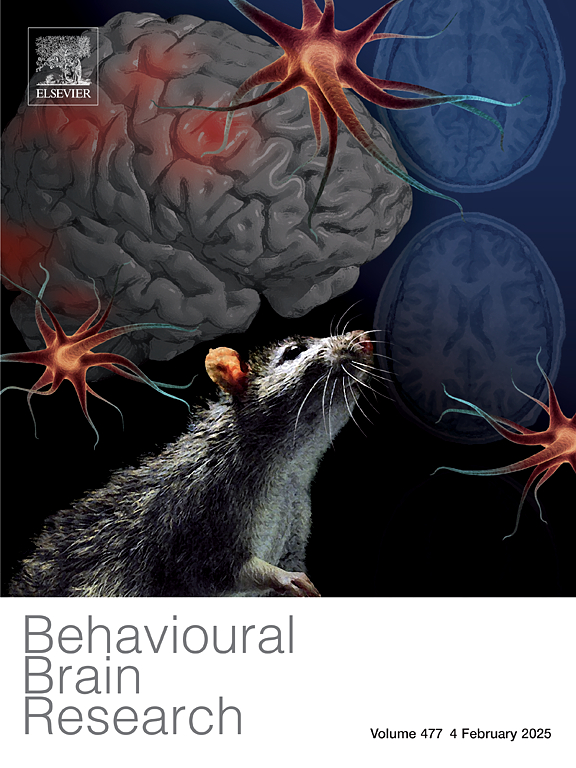赛博游戏中大脑结构、功能与社会排斥反应
IF 2.6
3区 心理学
Q2 BEHAVIORAL SCIENCES
引用次数: 0
摘要
社会排斥或拒绝是一种普遍的压力源,对拒绝的强烈反应与心理健康问题有关。先前的研究将排异反应与脑岛或扣带回等大脑活动联系起来,这些区域与疼痛处理有关。然而到目前为止,研究只研究了排异反应时大脑的状态,并没有研究排异反应中大脑更稳定的特征。确定哪些大脑区域对排斥反应更强烈,可以帮助我们更多地了解排斥敏感性的生物学基础,并最终缓解相关的心理健康问题。在这里,研究人员以1814名9- 12岁的多种族儿童为样本,研究了MRI扫描仪外的大脑结构、静息状态功能连接和排斥反应之间的关系。使用赛博球范式,观察到的情绪面部表情和自我报告的感受在同伴拒绝。静息状态下,背纹状体、视觉和感觉运动网络、扣带回-盖层和背注意网络之间的功能连通性与同伴拒绝时的负面情绪面部表情有关(beta = 0.11-0.12)。自我报告的反应和大脑结构没有关联。背纹状体与自动行为有关,这些网络和其他网络之间的功能连接可能表明为什么有些孩子在拒绝反应中更善于表达。扣带回和背侧注意网络的研究结果与早期的研究一致,表明休息时的大脑活动与被社会排斥时感到“受伤”的风险有关。本文章由计算机程序翻译,如有差异,请以英文原文为准。
Brain structure and function and social exclusion reactivity in the Cyberball game
Social exclusion or rejection is a universal stressor, and strong responses to rejection have been related to mental health issues. Previous studies linked rejection to concurrent brain activity in, amongst others, the insula or cingulo-operculum, areas related to pain processing. To date however, studies have only studied to the state of the brain during rejection, and not rejection in relation more stable brain characteristics. Identifying which brain areas are different among those that respond more to rejection could help us understand more of the biological underpinnings of rejection sensitivity and ultimately alleviate associated mental health issues. Here the relation between brain structure, resting-state functional connectivity and rejection reactivity outside of the MRI scanner was studied, in a multi-ethnic population-based sample of 1814 9-to-12-year-olds. Using the Cyberball paradigm, observed emotional facial expressions and self-reported feelings during peer rejection were measured. Stronger resting-state functional connectivity between the dorsal striatum, visual, and sensori-motor networks, and between the cingulo-operculum and dorsal attention network was related to negative emotional facial expressions during peer rejection (beta = 0.11–0.12). No associations were detected for self-reported reactions or brain structure. The dorsal striatum is related to automated behavior and functional connectivity between these and other networks may indicate why some children are more expressive in their reaction to rejection. Findings in the cingulo-operculum and dorsal attention network are in line with earlier studies, here suggesting that brain activity during rest is related to the risk of feeling ‘hurt’ when socially rejected.
求助全文
通过发布文献求助,成功后即可免费获取论文全文。
去求助
来源期刊

Behavioural Brain Research
医学-行为科学
CiteScore
5.60
自引率
0.00%
发文量
383
审稿时长
61 days
期刊介绍:
Behavioural Brain Research is an international, interdisciplinary journal dedicated to the publication of articles in the field of behavioural neuroscience, broadly defined. Contributions from the entire range of disciplines that comprise the neurosciences, behavioural sciences or cognitive sciences are appropriate, as long as the goal is to delineate the neural mechanisms underlying behaviour. Thus, studies may range from neurophysiological, neuroanatomical, neurochemical or neuropharmacological analysis of brain-behaviour relations, including the use of molecular genetic or behavioural genetic approaches, to studies that involve the use of brain imaging techniques, to neuroethological studies. Reports of original research, of major methodological advances, or of novel conceptual approaches are all encouraged. The journal will also consider critical reviews on selected topics.
 求助内容:
求助内容: 应助结果提醒方式:
应助结果提醒方式:


